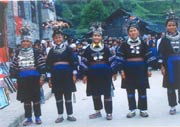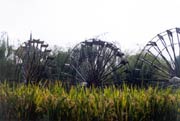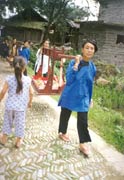
Dong is one of the ethnic minorities in China, with a population of 2,510,000, among which 1,400,000 are in Guizhou Province, 55.7% of the total number. There is a 1336-metre mountain in the boundary area of Hunan, Guizhou and Guangxi Province. As cock crows can reach the three provinces, the place is called "Three-Province Slope". The Dong people live here generation after generation, mainly in: Yuping and Tongren Counties, Southeast Qian (short for Guizhou) Autonomous Prefecture of Miao and Dong Ethnic Minority Groups, Guizhou Province; Xinshuang, Tongdao, and Zhijiang, Hunan Province; Sanjiang and Longsheng, Guangxi Province. They live together with some other ethnic groups such as Han, Miao, Zhuang, Yao, Shui, Buyi and Tujia, etc.
There is a 1336-metre mountain in the boundary area of Hunan, Guizhou and Guangxi Province. As cock crows can reach the three provinces, the place is called "Three-Province Slope". The Dong people live here generation after generation, mainly in: Yuping and Tongren Counties, Southeast Qian (short for Guizhou) Autonomous Prefecture of Miao and Dong Ethnic Minority Groups, Guizhou Province; Xinshuang, Tongdao, and Zhijiang, Hunan Province; Sanjiang and Longsheng, Guangxi Province. They live together with some other ethnic groups such as Han, Miao, Zhuang, Yao, Shui, Buyi and Tujia, etc.
The ancestors of Dong are a Luoyue branch, and offsprings of the Baiyue (a group of people in south China in ancient times). They were called "Liao" by Han people during the Wei, Jin, South and North Dynasties; "Geling" or "Ling" in the Song Dynasty; "Dongman", "Dongmiao", "Dongren", "Dongjia", or generally "Miao". Since the founding of the PRC, the group name was finally fixed as "Dong", according to their own wish.
The Dong language, belonging to Dong and Shui subgroup of Zhuang and Dong branch, Sino-Tibetan family, consists of south and north dialects, each having three branches. There used to be no written script of the Dong Language, and a new one was created in Pinyin in 1958. Now most of them use Chinese. Dong is an agricultural group, good at cropping rice, feeding fish in the rice field, and also managing forestry. The area is subtropical, convenient for trees and crops growing; one of the eight huge forest regions in China, known for its China fir trees, as well as economic forest tea-oil and tung oil.
Dong is an agricultural group, good at cropping rice, feeding fish in the rice field, and also managing forestry. The area is subtropical, convenient for trees and crops growing; one of the eight huge forest regions in China, known for its China fir trees, as well as economic forest tea-oil and tung oil.
The Dong people are good at singing and dancing. The Dong villages have the reputation of "a hometown of poetry and an ocean of songs." The Dong poetry has strict rhythm and a wide range of themes. The essence of their traditional culture is Dongzu Dage (great songs), with multiple voice parts and no accompaniment: of very precious value in both literature and music.
The Dong people love sticky rice, Dong Ba, and are especially fond of acid food. They make clothes with home-woven and home-dyed Dong cloth: short jackets, trousers and big headbands for the male; and the female wear short jackets, trousers or skirt with lots of swags. Silver ornaments are their favorites, like crown, chaplet, chain, bracelet, earring, etc. And they think that the more ornaments a female wears, the more beautiful she is. In terms of important festivals, the Dong people have the Spring Festival, the Dong New Year, the New Rice Festival, the Forest King Festival, the Fair-Going Festival. They have rich and colorful traditional entertainments and other public activities, such as "Duoye" (congregation singing and dancing), the March 3rd Singing Festival, grabbing fireworks, Lusheng agora, bullfighting, carrying husband, etc.
In terms of important festivals, the Dong people have the Spring Festival, the Dong New Year, the New Rice Festival, the Forest King Festival, the Fair-Going Festival. They have rich and colorful traditional entertainments and other public activities, such as "Duoye" (congregation singing and dancing), the March 3rd Singing Festival, grabbing fireworks, Lusheng agora, bullfighting, carrying husband, etc.
The Dong people are adept at house building. Their art of architecture is not only peculiar, but also elevated in skills and refined in taste. Beside the common railing houses, they build drum-towers and wind-and-rain bridges, which is the essence of their architecture art and are world-famous.
You will only receive emails that you permitted upon submission and your email address will never be shared with any third parties without your express permission.
